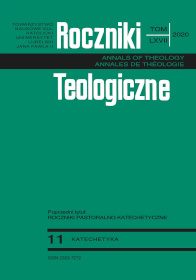Theological and Canonical Aspects of Baptismal Mystagogy to Persons below 14 Years of Age
Abstract
The aim of this article is to present the theological grounds for administering baptism to children and minors under 14 years of age and the canonical status of it, as well as the pastoral and administrative implications arising therefrom. The consequence of baptism is the sanctifying and justifying incorporation into the People of God’s New Covenant. It cannot be revoked, and its sacramental character is irremovable. Man, reborn with baptismal water, is freed from Adam’s guilt and endowed with the power to overcome evil. The author refers to the thesis that the baptism of children violated their religious freedom. The article states that there is no such thing as “pure human freedom,” independent of any influence. Parents care for the well-being of their children and things necessary for life. This also applies to religious life. Not caring about this aspect would in fact be a wish of evil by depriving a person of a good. The author describes the consequences arising from the sacrament of baptism, through which a legal node is created in a particular Church sui iuris.
References
Adamowicz, Leszek. Wprowadzenie do prawa o sakramentach świętych: według Kodeksu Prawa Kanonicznego oraz kodeksu Kanonów Kościołów Wschodnich. Lublin: Polihymnia, 1999.
Bartnik, Czesław S. Dogmatyka katolicka. Vol. 2. Lublin: Wydawnictwo KUL, 2013.
Biszko, Tomasz. “Sakrament chrztu św. w świetle Katechizmu Kościoła Katolickiego.” Legnickie Studia Teologiczno-Historyczne 14 (2009): 45–59.
Blanco, María, “Coment. sub can. 868.” In Marzoa, Miras, and Rodríguez-Ocaña, Comentario Exegético al Código de Derecho Canónico, 3:487–89.
Catechism of the Catholic Church. Chicago: Loyola University Press, 1994.
Codex Iuris Canonici auctoritate Ioannis Pauli PP. II promulgatus, January 25, 1983: AAS 75 (1983), pars II, 1–317.
Codex Iuris Canonici auctoritate Pii X Pontificis Maximi iussu digestus Benedicti. Papae XV auctoritate promulgatus, May 27, 1917: AAS 9 (1917), pars. II, 1–593.
Congregation for the Doctrine of the Faith. Instruction on Infant Baptism Pastoralis actio, October 20, 1980: AAS 72 (1980), 1137–56. https://www.vatican.va/roman_curia/congregations/cfaith/documents/rc_con_cfaith_doc_19801020_pastoralis_actio_en.html.
Góralski, Wojciech. “Wymiar ekumeniczny Kodeksu Prawa Kanonicznego Jana Pawła II.” Roczniki Nauk Prawnych 1–2 (1991–1992): 17–28.
International Theological Commission. The Hope of Salvation for Infants Who Die without Being Baptised. London: Catholic Truth Society, 2007. Also available on http://www.vatican.va/roman_curia/congregations/cfaith/cti_documents/rc_con_cfaith_doc_20070419_un-baptised-infants_en.html.
Kamiński, Rafał. “Wychowanie dzieci w małżeństwach mieszanych.” In Chrzest i małżeństwo: harmonizacja ustawodawstwa, edited by Henryk Stawniak and Rafał Kamiński, 109–43.Warsaw: Scriptum, 2018.
Krzywda, Józef. “Chrzest.” In Komentarz do Kodeksu prawa kanonicznego. Vol. 3/2, Księga IV. Uświęcające zadanie Kościoła, edited by Wojciech Góralski, Edward Górecki, Józef Krukowski, Józef Krzywda, Piotr Majer, and Bronisław Zubert, 35–65. Poznań: Pallottinum, 2011.
Marzoa, Ángel, Jorge Miras, and Rafael Rodríguez-Ocaña, eds. Comentario Exegético al Código de Derecho Canónico. 4 vols. Pamplona: EUNSA, 1996.
Mikołajczuk, Krzysztof. Realizacja zasady jedności sakramentów wtajemniczenia chrześcijańskiego w prawodawstwie Kościoła Katolickiego. Kielce: Jedność, 2006.
Müller, Gerhard L. Dogmatyka katolicka. Kraków: WAM, 2015.
Nadolski, Bogusław. Leksykon liturgii. Poznań: Pallottinum, 2006.
Pawluk, Tadeusz. Prawo kanoniczne według Kodeksu Jana Pawła II. Vol. 1, Zagadnienia wstępne i normy ogólne. Olsztyn: Warmińskie Wydawnictwo Diecezjalne, 2015.
Pawluk, Tadeusz. Prawo kanoniczne według Kodeksu Jana Pawła II. Vol. 2, Lud Boży jego nauczanie i uświęcanie. Olsztyn: Warmińskie Wydawnictwo Diecezjalne, 2010.
Pontifical Council for Promoting Christian Unity. Directoire pour l’application des principes et des normes sur l’oecuménisme, March 25, 1993: AAS 85 (1993), 1039–119.
Rincón-Pérez, Tomás. “Disciplina canónica del Culto Divino.” In Manual de derecho canónico, obra a cargo del Instituto Martín de Azpilcueta, 405–548. Pamplona: EUNSA, 1988.
Rincón-Pérez, Tomás. La liturgia e i sacramenti nel diritto della Chiesa. Rome: EDUSC, 2014.
Rite of Baptism for Children, Washington, D.C.: United States Catholic Conference, 1969.
Vatican Council II. Dogmatic Constitution on the Church Lumen gentium, November 21, 1964: AAS 57 (1965), 5–75. https://w2.vatican.va/archive/hist_councils/ii_vatican_council/documents/vat-ii_const_19641121_lumen-gentium_en.html.
Vatican Council II. Declaration on Religious Freedom Dignitatis humanae, December 7, 1965: AAS 58 (1966), 929–46. http://www.vatican.va/archive/hist_councils/ii_vatican_council/documents/vat-ii_decl_19651207_dignitatis-humanae_en.html.
Syczewski, Tadeusz. “Sakrament Chrztu Świętego.” Studia Teologiczne-Białystok-Drohiczyn-Łomża 15 (1997): 155–76.
Copyright (c) 2020 Roczniki Teologiczne

This work is licensed under a Creative Commons Attribution-NonCommercial-NoDerivatives 4.0 International License.





